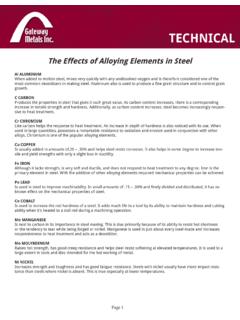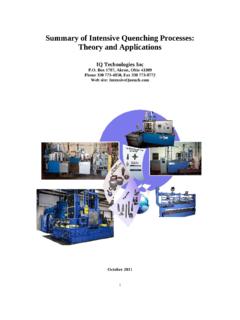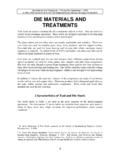Transcription of A Simplified Guide to Heat Treating Tool Steels
1 Page 1A Simplified Guide to heat Treating Tool SteelsWhen we consider that the greater overall costs of most tools and dies are incurred prior to heat treatment and further that proper heat treatment is critical to the successful application of tooling, this so-called hardening process is placed in it s proper perspective of importance. While there are a number of specialized procedures which can be employed in the heat treatment of tool Steels , the purpose of this discussion is to review the basic heat Treating process, it s steps and terms, and perhaps offer some helpful hints along the heat Treating ProcessThe process consists of:A) PREHEATING the Annealed tool, typically at 1250 degrees ) AUSTENITIZING (Soaking at High heat ).
2 C) quenching Quench to Hard Brittle (Martensite) ) TEMPERING (Drawing to desired hardness).AnnealingTool Steels are furnished in the annealed condition which is the soft, machineable and necessary condition for proper heat treat response. The exceptions to this are the prehardened Steels such as P-20, Brake Die, Holder Block and Maxel Tooling Plate which are furnished at 28/32 HRC and used at that Steels should always be annealed prior to re-hardening and annealed Steels should be re-annealed after welding. Unlike hardening which requires a quench after soaking at the hardening temperature, the essence of annealing is very slow cooling from the annealing temperature.
3 By way of example, A2 tool steel is annealed by heating to 1550 degrees F, soaking for two hours at temperature, furnace cooling 50 degrees F per hour to below 1200 degrees F followed by air cooling. Some shops anneal late in the day after all other heat Treating has been finished by simply soaking the part to be annealed at the proper annealing temperature and then turning the furnace off. The next morning the part is fully annealed and ready for plays no part in the actual hardening reaction and is often considered an unnecessary step.
4 However, preheating performs at least one major function, it minimizes thermal shock, thus reducing the danger of excessive distortion, warping or cracking. As a matter of fact, intricate tools and particularly high speed Steels , are often preheat-ed in two steps: one below the transformation temperature and the second right at the transformation temperature. Preheating does not require soaking but the tool should be equalized at the preheat temperature. Remember, always bring your tools up with the furnace to the preheating (High heat )Austenitizing depends upon time and temperature, thus the common term, soak at high heat .
5 Of the two, temperature is the most critical. Never exceed the high heat range for the grade. Excessive temperature will cause erratic results. Classic symptoms of overheating are low as-quenched hardnesses and, depending upon the alloy content, shrinkage and loss of magnetic properties. Soaking time should always be after the steel has caught up with the furnace tempera-ture. With the exception of high speed Steels , a rule of thumb for soak time is one half hour per inch of thickness with a forty-five minute minimum and if in doubt over how long to soak a tool, soak it longer never less.
6 High speed Steels are essentially equalized with the furnace temperature as opposed to soaking due to the fact that the high heat range is so close to the melting point. Essentially, high speed Steels are equalized at the austenitizing (High heat ) temperature in minutes of furnace time, never 2A Simplified Guide to heat Treating Tool SteelsQuenchingQuenching must be done promptly in the medium prescribed for the grade with the exceptions discussed further. Actually, Water Hardening Steels are properly quenched in brine.
7 A pound of salt to a gallon of water is a good Guide . Oil Hardening Steels should be quenched in circulated commercial quenching oil which has been heated to 100/125 de-grees F. In either case, the liquid quenching bath should contain sufficient volume to prevent the bath from exceeding the proper bath temperatures. Air Hardening Steels will harden in still air in small sections. However, medium to large sections may require a light, evenly distributed fan blast. A fan blast on only one side of a section may cause uneven quenching which will result in sections in certain air hardening grades will not develop full as- quenched hardness unless they are started in oil.
8 This process is commonly called interrupted oil quenching . Simply stated, the tool is quenched into oil until the section just turns black followed by air cooling. S7, an air hardening -shock resisting tool steel , is a classic example of a steel which will not develop full hardness in larger sections unless it is given an interrupted oil Speed Steels are basically considered oil hardening, however, to minimize distortion, high speed Steels are com-monly hardened with an interrupted oil quench or quenched in hot quenching salt at 1000 degrees F followed by air.
9 Vacuum heat Treating furnaces do not allow quenching outside of the furnace unless the vacuum furnace has been equipped with an attendant oil quenching zone. Small and medium sections of air hardening steel will devel-op full hardness when quenched by the inert gas backfill. However, larger sections will not develop full hardness unless the inert gas backfill has sufficient capacity. Some vacuum furnaces have an adjustable large capacity pressure pump to insure sufficient gas flow to develop faster quenching rates.
10 Do not temper until the tool reaches about 125 degrees F (handling temperature). If tools cannot be promptly tempered, placing them in a container of boiling water (212 de-grees F) will prevent cracking due to quenching stresses until tempering can be (Drawing)Upon quenching , tool Steels are in a highly stressed condition. To avoid cracking, tools should be tempered immedi-ately after quenching . As with Austenitizing, tempering is dependent on temperature and time. The temperature must be closely controlled, to develop the desired hardness range.







